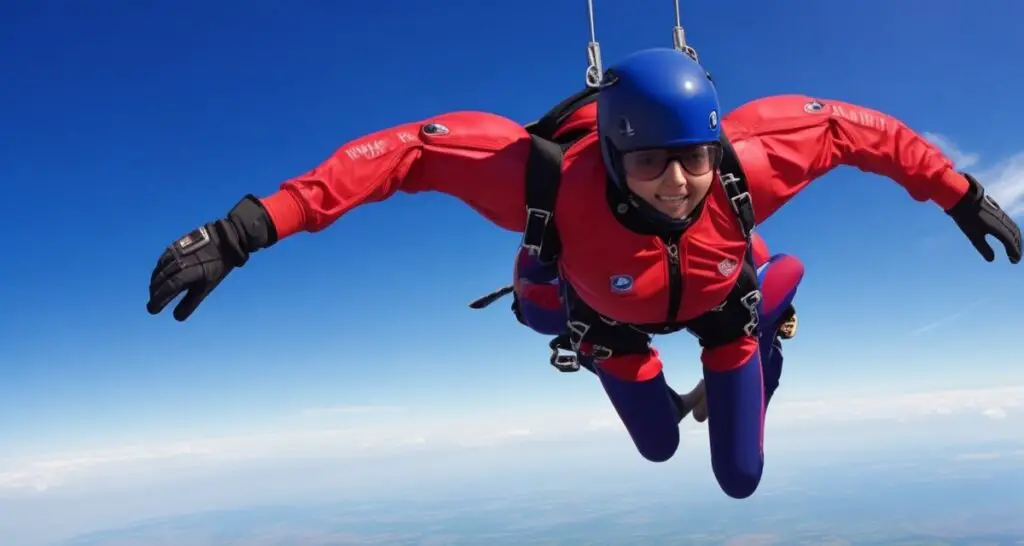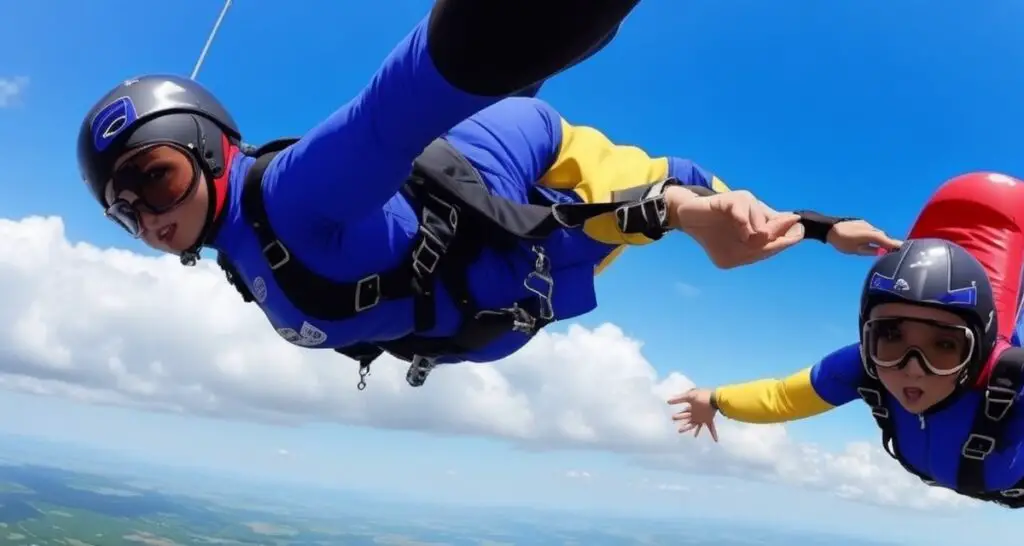Curious about the cost of taking the plunge into the thrilling world of skydiving? “How much does it cost to go skydiving?” is a question that often comes to mind. In this brief overview, we’ll explore the factors that influence skydiving costs, providing you with essential insights before you make the leap.
MEANING AND UNDERSTANDING OF SKYDIVING

Skydiving is an exhilarating recreational activity that involves jumping out of an aircraft from a certain altitude and free-falling before deploying a parachute to safely descend to the ground. This thrilling experience allows individuals to feel the rush of adrenaline while enjoying breathtaking views from high above the Earth’s surface.
During a skydive, participants are guided by experienced instructors who ensure safety protocols are followed. Before the jump, comprehensive training is provided to familiarize individuals with the equipment, proper body positioning, and emergency procedures. This preparation ensures that participants have a basic understanding of what to expect and how to react during the descent.
As you leap from the plane, you’ll experience an initial sensation of weightlessness during free fall. The wind rushing past you creates a unique feeling of flying as you take in the stunning scenery around you. After a predetermined time, the parachute is deployed, gently slowing your descent. This phase offers a serene and almost meditative experience as you glide gracefully through the air, soaking in the surroundings.
Skydiving is more than just an adrenaline rush; it’s an opportunity to conquer fears, challenge oneself, and gain a new perspective on the world. It’s an adventure that combines excitement with awe-inspiring views and personal growth. Whether you’re an experienced skydiver or trying it for the first time, each jump offers a chance to connect with the sky in a way that words can hardly describe.
WHY PEOPLE ARE FOND OF SKYDIVING

Embracing Thrill and Freedom:
Skydiving offers a unique combination of excitement and the sensation of freedom. The thrill of jumping out of an airplane and free-falling through the air provides an adrenaline rush that many find incredibly captivating. The feeling of weightlessness and the wind rushing past create an extraordinary experience that is hard to replicate elsewhere.
Overcoming Boundaries:
For many, skydiving represents an opportunity to face and conquer personal fears. The act of willingly jumping out of an aircraft at a high altitude challenges individuals to confront their anxieties and step outside their comfort zones. This achievement fosters a deep sense of empowerment and accomplishment, leading to increased self-confidence.
Connecting with Awe: The chance to witness stunning landscapes from thousands of feet above the ground is a major draw for skydiving enthusiasts. The breathtaking views create a profound connection with the beauty of the world and a unique perspective that is difficult to achieve through other means. This connection with nature’s grandeur can be incredibly moving and memorable.
Building Inner Resilience:
Skydiving is not just a physical adventure but also a mental challenge. The process of preparing for a jump, managing fear, and staying composed during the free fall nurtures inner resilience. Overcoming the mental barriers associated with skydiving contributes to personal growth and a stronger mindset that extends beyond the activity itself.
Unbreakable Bonds:
The shared experience of skydiving often leads to the formation of close-knit communities. Skydiving enthusiasts connect through their mutual love for the activity, forging lasting friendships and connections. The camaraderie built around this common interest enhances the overall experience and creates a sense of belonging.
Capturing Life’s Essence:
Skydiving embodies the essence of living in the moment. The intense focus required during the jump, the rush of emotions, and the serene moments while gliding under the parachute create a memorable experience that stays with individuals for a lifetime. The stories and memories from skydiving become cherished parts of one’s personal narrative.
Pushing Personal Limits:
Skydiving serves as a platform for pushing one’s personal boundaries. It encourages individuals to step beyond their comfort zones and embrace new challenges. The act of willingly participating in such an adventurous and daring activity promotes personal growth, self-discovery, and an increased willingness to take on other life challenges.
Admiring Human Potential:
The act of skydiving showcases the remarkable capabilities of human beings. It’s a testament to human innovation, courage, and the desire to explore and conquer new frontiers. Observing oneself and others master the skies fosters a sense of wonder and admiration for the potential that resides within us.
An Everlasting Passion:
Skydiving often becomes more than just a one-time experience; it can evolve into a lifelong passion. The unique blend of adventure, excitement, and tranquility that skydiving offers creates an enduring attraction. Those who become passionate about skydiving continue to seek out new opportunities to enjoy the activity and connect with like-minded individuals.
Physical REQUIREMENTS FOR THE SKYDIVING

- Tandem Skydive:
For a tandem skydiving experience, which includes all the essential equipment, the cost usually ranges between $120 and $250. It’s worth noting that while the cost covers the equipment, it’s customary to consider a tip for your instructor, generally around 10-20% of the total cost. - Solo Skydive:
If you’re considering a solo skydive, the pricing can vary. It generally falls within the range of $80 to $120. However, if you have your own equipment and only require a ride up to the altitude, the cost can be as low as $25. Remember, for this option, prior training and certification from the USPA are prerequisites. - Accelerated Free Fall (AFF) Training Package:
If you’re interested in the comprehensive AFF Training package, which includes 7-10 jumps along with training sessions, equipment, and transport to altitude, the cost typically amounts to approximately $1,500. It’s important to keep in mind that this package involves around 8 hours of on-ground training before your first jump. - Indoor Skydiving:
For those intrigued by indoor skydiving, the cost ranges from about $20 to $30 per minute. This mimics the freefall segment of an actual skydiving jump from 10,000 to 14,000 feet, which usually lasts around 30 seconds to a minute landing.
legal REQUIREMENTS FOR THE SKYDIVING

- Age Restrictions:
The legal age to participate in skydiving varies by location, but typically you must be at least 18 years old. Some places might allow younger individuals to jump with parental consent. - Health and Fitness:
Skydiving requires a certain level of physical fitness. You may need to provide a medical certificate or undergo a health assessment to ensure you’re in suitable condition for the activity. - Liability Waivers:
Before participating, you’ll likely be required to sign a liability waiver. This document acknowledges the inherent risks of skydiving and releases the skydiving center or company from liability in case of injuries. - Training and Certification:
If you’re doing solo jumps, completing a training program and obtaining the necessary certification is often mandatory. This ensures you have the skills to handle various situations that might arise during a jump. - Weight Restrictions:
Skydiving centers often impose weight limits for safety reasons. These limits might vary based on the type of jump, equipment, and the specific aircraft being used. - Alcohol and Substance Restrictions:
Many skydiving centers have strict rules against participating under the influence of alcohol or drugs that could impair your judgment or coordination. - Respect for Regulations:
Following the instructions of your instructor and adhering to the guidelines of the skydiving facility is essential. This includes wearing appropriate attire, understanding the jump procedures, and abiding by safety protocols.
It’s crucial to thoroughly research and understand the legal requirements set by the skydiving center or company you plan to jump with. Meeting these requirements ensures not only your safety but also compliance with the law during your skydiving experience.
Consideration of Skydiving Prices:
HOW MUCH DOES IT COST TO GO SKYDIVING?
Are you interested in experiencing the thrill of skydiving but uncertain about the associated costs? The total expense for your skydiving adventure hinges on several key factors:
- Type of Skydiving: Whether you opt for a tandem skydive, where you’re connected to an instructor, or a solo jump.
- Equipment: If you’re jumping solo, you can choose between renting the necessary equipment or using your own gear.
- Package Selection: Your costs may vary based on whether you choose a standalone jump or a comprehensive program/package.
- Location: The cost can also be influenced by your geographical location, whether it’s within the country or internationally.
- Skydiving Company: Different companies may offer varying pricing structures for their services.
- Additional Services: Consider if you’d like to include extra services like video recording and photographs of your dive.
- Timing: Weekdays and weekends might have different pricing, so this is worth considering.
- Type of Dive: You should differentiate between a standard skydive and an indoor simulation using a vertical wind tunnel.
For those new to skydiving, who are testing the waters of this exhilarating experience, selecting a tandem jump is a prudent choice. It doesn’t require any training, allowing you to entrust all technical aspects to your skilled instructor. This approach enables you to relish the adventure without concerning yourself with the details.
Alternatively, if your interest lies in the sensation of soaring through the air without the actual free fall and panoramic views, indoor skydiving provides a great option.
On the other hand, if you’re deeply passionate about the thrill of skydiving and wish to exercise control over deploying your parachutes precisely, investing in proper training is recommended. While this entails an initial investment of time and money, it will ultimately lower your long-term expenses by eliminating the need for an instructor’s presence during every jump.
Points to know How much does skydiving cost?
Tandem Skydive:
For a tandem skydiving experience, which includes all the essential equipment, the cost usually ranges between $120 and $250. It’s worth noting that while the cost covers the equipment, it’s customary to consider a tip for your instructor, generally around 10-20% of the total cost.
Solo Skydive:
If you’re considering a solo skydive, the pricing can vary. It generally falls within the range of $80 to $120. However, if you have your own equipment and only require a ride up to the altitude, the cost can be as low as $25. Remember, for this option, prior training and certification from the USPA are prerequisites.
Accelerated Free Fall (AFF) Training Package:
If you’re interested in the comprehensive AFF Training package, which includes 7-10 jumps along with training sessions, equipment, and transport to altitude, the cost typically amounts to approximately $1,500. It’s important to keep in mind that this package involves around 8 hours of on-ground training before your first jump.
Indoor Skydiving:
For those intrigued by indoor skydiving, the cost ranges from about $20 to $30 per minute. This mimics the freefall segment of an actual skydiving jump from 10,000 to 14,000 feet, which usually lasts around 30 seconds to a minute.
Tunnel Skydiving (Indoor Skydiving):
This involves experiencing the sensation of freefall in a vertical wind tunnel. Prices vary, but you can expect to pay around $30 to $60 for a few minutes of tunnel time, depending on the location and package.
Static Line Jump:
In this method, your parachute is deployed automatically as you exit the aircraft. The cost for a static line jump can range from $100 to $200, depending on the location and the number of jumps included in the package.
Wingsuit Skydiving:
Wingsuit flying allows you to glide through the air like a bird after freefalling. Prices for wingsuit jumps are typically higher due to the specialized equipment and training required. They can range from $200 to $400 per jump.
HALO (High Altitude Low Opening) Jump:
HALO jumps involve jumping from extremely high altitudes and opening the parachute at low altitudes. Due to the advanced nature of this type of jump, prices can start from $500 and go up to $1000 or more.
Night Skydiving:
Some skydiving centers offer the thrill of jumping at night. Night jumps often come with additional safety measures and considerations, and they can cost around $200 to $300.
Wingsuit Tunnel Flying:
Similar to indoor skydiving, some facilities offer wind tunnels for practicing wingsuit flying. Prices can be similar to regular indoor skydiving, ranging from $30 to $60 for a few minutes.
these prices are approximate and can vary widely based on factors like location, the number of jumps in a package, additional services, and the reputation of the skydiving center. It’s always a good idea to check with specific skydiving centers for their current rates and packages.
Top tips to reduce skydiving costs:
Group Jumps: Consider forming a group of five or more individuals as this often unlocks a generous discount ranging from 10% to 20%. Embracing the camaraderie of a group can make your skydiving adventure even more memorable.
Weekday Excursions:
Opting for a jump during weekdays can be a strategic move. Given that weekends are popular among leisure jumpers, weekdays might offer a more budget-friendly opportunity to experience the thrill.
Personal Equipment:
If you anticipate engaging in multiple jumps over the next few years, bringing your own equipment could be a wise investment. While the cost of a complete parachute kit varies, owning your gear can lead to substantial savings.
Selecting Affordable Locations:
Choosing skydiving locations in areas with lower living costs can result in more economical jumping expenses. For instance, tandem skydives in locales like Houston tend to be around $180, compared to around $250 in high-cost cities such as New York.
Immediate Booking Advantage:
Harness the energy of your recent exhilarating jump by considering booking subsequent jumps on the same day. Many skydiving companies extend appreciable discounts on your second jump when scheduled immediately after your first.
Mindful of Weight:
Being mindful of weight considerations can impact your costs. Some skydiving companies may adjust charges for individuals weighing over 200 lbs due to increased fuel usage and extended pilot time.
Seek Promotional Opportunities:
Keep an eye out for promotional offers, particularly during quieter months characterized by cooler weather or cloud cover. Companies may introduce discounts or special promotions, allowing you to enjoy the thrill while saving, such as the potential 2-for-1 offers.
It’s wonderful to explore these avenues to enhance your skydiving experience while being mindful of your budget. Each approach introduces a unique way to make your adventure more accessible and affordable, ensuring you can savor every moment of your jump.
CONCLUSION
In the realm where earth meets sky, the cost of a leap defies mere arithmetic. It transcends currency, becoming a coin of exhilaration minted in the heart. The price? Courage. The reward? Freedom. As you step onto the precipice, calculations fade, replaced by the infinity of possibilities below. Your wallet may lighten, but your spirit soars weightless, embracing the horizon’s promise. So remember, the true cost of skydiving is measured not in dollars, but in the priceless moments etched into the canvas of memory, reminding us that some experiences are worth every penny and every heartbeat.
FAQs
How much does it generally cost to go skydiving?
The cost of skydiving can vary widely depending on several factors, including the location, type of jump, and additional services. On average, a tandem skydive, where you’re harnessed to an experienced instructor, can range from $150 to $300. However, this cost might not include extras like photos or videos.
What are the different types of skydiving jumps and their costs?
Tandem Skydive: As mentioned earlier, a tandem jump is one of the most common types for beginners. Prices range from $150 to $300, but they might go higher if you opt for additional services like videos and photos.
Accelerated Freefall (AFF): AFF is a training program that allows you to jump solo after a series of training jumps. The cost for the full AFF course can range from $1,200 to $2,500, depending on the number of jumps and instruction included.
Static Line Jump: This is another training method where a static line attached to the aircraft deploys your parachute automatically. The cost is usually around $200 to $300 per jump.
Why does the cost of skydiving vary between locations?
Skydiving costs can differ due to several factors:
Location: Areas with higher costs of living might have higher prices for skydiving.
Scenic Views: Skydiving over picturesque landscapes or popular tourist spots might come at a premium.
Facilities: Drop zones with better facilities and equipment might charge more.
Are there any additional costs to consider when skydiving?
Yes, there can be additional costs:
Photos and Videos: Many skydiving centers offer photo and video packages of your jump, usually ranging from $50 to $150.
Gear Rental: Some places might charge extra for gear rental if it’s not included in the initial price.
Tip for Instructors: While not mandatory, tipping your instructor is a common practice to show appreciation for their guidance and support.
Are there any age, weight, or health restrictions for skydiving?
Yes, there are generally restrictions:
Age: Most places require you to be at least 18 years old to skydive. Some might allow 16 or 17-year-olds with parental consent.
Weight: There’s often a weight limit due to safety reasons, as equipment has weight limits. This limit can vary but is typically around 220 to 250 pounds (100 to 113 kg).
Health: Skydiving requires a certain level of physical fitness. Individuals with certain medical conditions might need a doctor’s clearance to jump.

